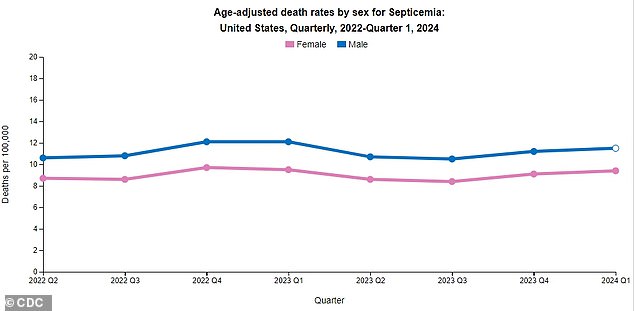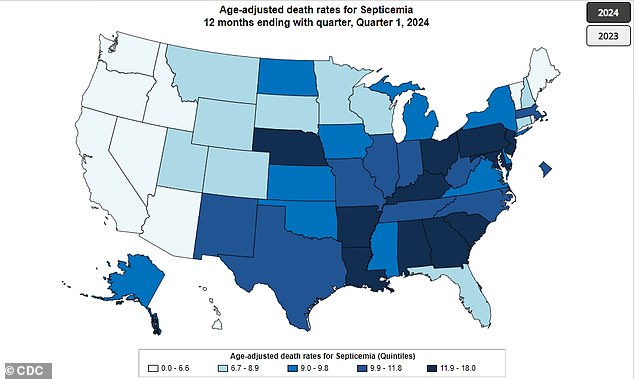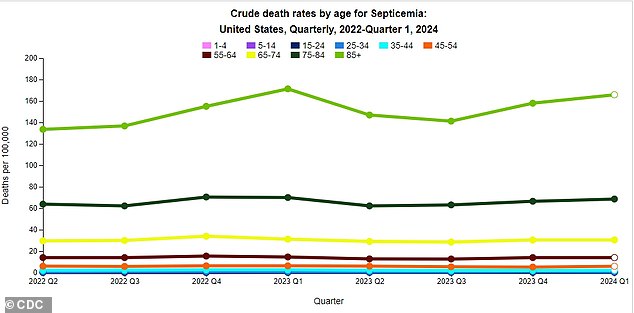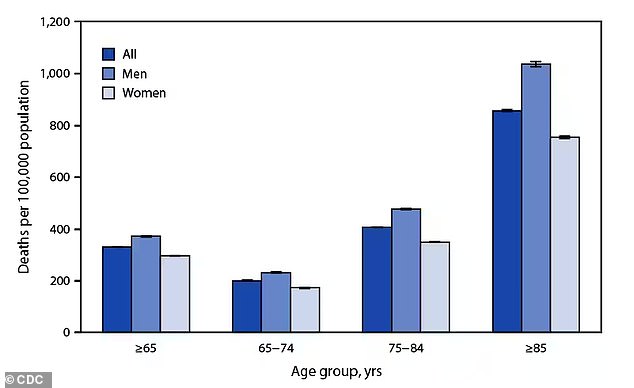Rise of ‘silent killer’ that strikes as many Americans as CANCER every year – yet millions have never heard of it
It is the third leading cause of death in the US, killing more people than dementia and affecting as many people as cancer.
Yet millions of Americans have never heard of it.
That’s why sepsis is also called a “silent killer.” It occurs when the body overreacts to an infection, causing the immune system to go into overdrive and violently attack healthy tissue.
Another reason for the name is that the disease often starts with seemingly harmless symptoms, such as fever, fatigue and shortness of breath.
But within hours it can lead to multi-organ failure, heart attacks and amputations.
New data from the CDC shows a small but significant increase in the disease. The South and Appalachia are most vulnerable, as are wealthy states along the East Coast.
The latest sepsis data from the CDC shows a slight increase in sepsis deaths over the past three months, which experts say could be due to a lack of a cohesive sepsis strategy in the U.S.

Sepsis can affect patients of all ages, including three-year-old Beauden Baumkitchner, who had both legs amputated after scraping his knee and contracting staph bacteria
The factsfrom the CDC’s National Center for Health Statistics, examined death rates from sepsis from late 2022 through 2024.
Overall, the number of deaths from sepsis increased slightly, from 9.3 cases per 100,000 to 10.3 cases per 100,000. That is an increase of just under one percent.
From 2022 to 2024, men were structurally at higher risk of dying from sepsis, with a death rate of 11.5 per 100,000 in the first quarter of 2024, compared to 9.4 per 100,000 in women.
Most age groups remained stable over the past two years, but for the age group 85 and older, the number rose from 141 per 100,000 in the third quarter of 2023 to 166 per 100,000 in 2024.
As of the first quarter of 2024, the southern and Appalachian states had the highest rates of sepsis deaths. Louisiana had the most, at 18 per 100,000, followed closely by Kentucky and Arkansas at 17 per 100,000.
While these states have historically been prone to chronic diseases such as obesity, diabetes and cancer, all of which are risk factors for sepsis, wealthier states along the East Coast also recorded higher rates of sepsis.
For example, New Jersey has a sepsis death rate of 16 per 100,000, followed by Maryland and Pennsylvania at 14 and 13 per 100,000, respectively.

According to the CDC, men are consistently more likely to die from sepsis than women

The map above shows the average sepsis death rates in each US state per 100,000 residents
Experts have suggested that the steady increase in the condition, in which the immune system overreacts to an infection and attacks healthy organs, could be due to a lack of coherent care in the U.S.
Unlike the United Kingdom, Australia, and several other countries, the US does not have a national sepsis protocol. CDC Data 2023 found that more than 1,400 hospitals—about a quarter—in the U.S. have no sepsis program at all.
And just over half of them give staff time to focus on developing a sepsis protocol.
However, the new CDC data does show that the number of hospitals with a sepsis program increased from 73 percent to 78 percent from 2022 to 2023.
“Doctors are not being given enough information to diagnose sepsis,” Dr. Steven Simpson, a professor of medicine at the University of Kansas and president of the nonprofit Sepsis Alliance, previously told DailyMail.com.
‘There is no catchy slogan that doctors and hospitals can use to draw attention to this, as is the case in other countries.
“Every hospital in the country should have a sepsis committee, a sepsis quality improvement program, and organize their facility to be prepared to recognize and treat sepsis. Right now, that’s absolutely not the case.”
Sepsis affects more than 1.7 million Americans each year, comparable to cancer, which is diagnosed in 1.9 million people and is also on the rise in the U.S.
Sepsis kills more than 350,000 people a year, or one person every 90 seconds. Only cancer and heart disease kill more in the U.S., with 600,000 and 700,000 deaths, respectively.
Although these diseases mainly affect older people, the scary thing is that sepsis can affect anyone.
People aged 65 and over are generally the most vulnerable, although approximately 75,000 patients each year are under the age of 18.
It is also the leading cause of death in hospitals: one in three deaths is caused by this type of disease.
According to the Sepsis Alliance, sepsis claims more lives “than people who die from stroke, prostate cancer, breast cancer, and opioid overdose combined.”
Globally, the condition accounts for one in five deaths (20 per minute) and outnumbers cancer in deaths.
But despite the condition’s devastating prevalence, one in three Americans has never heard of it, the Sepsis Alliance found.
And sepsis isn’t even on the CDC’s list of “leading causes of death,” though it’s unclear why.

The following graph shows that people aged 85 and older have had the largest spike in sepsis deaths over the past two years

Most sepsis patients are over 85 years of age, although it has been known to affect patients from a young age
The lack of awareness can make it harder for patients to recognise the condition and seek immediate help, sepsis survivor Don Smith previously told DailyMail.com.
Mr Smith, now 67, developed sepsis in 2017 after contracting a throat infection, unaware of the violent reaction in his body.
But within a few days his foot had swollen so much that he could not get out of bed. He had several toes amputated because they had turned black from lack of circulation.
Up until that point, he had only a vague idea of what sepsis was. And several other patients he has met have said that their doctors simply told them, “You were very sick,” instead of telling them they were septic.
“Use the word sepsis. Tell people what it is and what it means, because I had heard the word sepsis before, but I had no idea what it was,” Mr. Smith said.
“And I almost died from it. We need to spread the word so less people die.”

“Use the word sepsis. Tell people what it is and what it means, because I’ve heard the word sepsis before, but I had no idea what it was,” Mr. Smith said. “And I almost died from it. We need to get the word out so that fewer people die.”

Sepsis also carries the risk of repeated hospitalization, as it can cause permanent organ damage and other long-term effects. Chloe Cummings (left) and her mother Kimberly have both become septic about 18 times and are constantly at risk of being hospitalized.
Another danger is that sepsis can make the body more vulnerable to repeated attacks. The Sepsis Alliance, for example, estimates that a third of sepsis survivors end up back in the hospital within three months, usually because of the repeated attacks.
In many patients, sepsis causes permanent damage to organs such as the lungs, brain and heart. This damage requires long-term maintenance and can lead to repeated hospitalizations.
A new study published this week in the journal American Journal of Intensive CareFor example, it was found that of the 7,100 patients with sepsis, almost one in four was readmitted to hospital within 30 days.
Two-thirds of these were caused by repeated attacks of sepsis and almost half by infections.
Priscilla Hartley, co-author of the study and assistant professor of nursing at Augusta University in Georgia, said that nine out of 10 cases involved readmissions of patients who were “deemed healthy enough to be sent home or to home health care.”
Chloe Cummings, 30, has had sepsis more than a dozen times since she was a child. Her mother previously told DailyMail.com that sepsis was affecting her daughter’s bones, leaving her frequently hospitalized because something as innocuous as falling off a swing could result in a fracture or dislocation.
“It’s just a reminder that you don’t get out of this unscathed,” Ms Cummings said.
